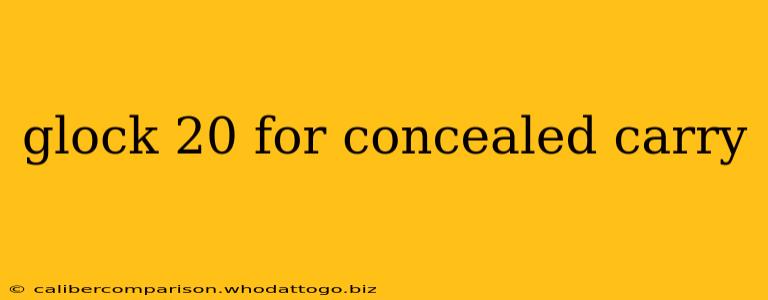The Glock 20, chambered in the powerful 10mm Auto, is a popular handgun among enthusiasts, but is it suitable for concealed carry? This question sparks considerable debate among gun owners, and the answer, as with most firearm choices, is nuanced. This article delves into the pros and cons of carrying a Glock 20 concealed, offering a realistic assessment to help you make an informed decision.
The Allure of the 10mm: Power and Stopping Power
The Glock 20's primary appeal lies in its potent 10mm Auto cartridge. This round delivers significantly more stopping power than the ubiquitous 9mm, making it a compelling choice for self-defense. The increased energy transfer translates to a higher likelihood of incapacitating a threat, a crucial factor in high-stakes situations. This raw power is a significant advantage for those who prioritize stopping power above all else.
Concealability Challenges: Size and Weight
However, the Glock 20's substantial size and weight present significant challenges for concealed carry. The larger frame and heavier slide make it less comfortable to carry discreetly than smaller handguns. This is particularly true for individuals with smaller builds or those who prefer appendix carry. While it can be concealed, it requires careful consideration of clothing choices and a robust, comfortable holster.
Clothing Considerations: More is Better
Successfully concealing a Glock 20 demands strategic clothing choices. Loose-fitting jackets, oversized shirts, and even strategically chosen outerwear can help mask the weapon’s bulk. However, this often limits your wardrobe options and may be impractical in warmer climates.
Holster Selection: Crucial for Comfort and Safety
Finding the right holster is paramount for comfortable and safe concealed carry with the Glock 20. High-quality, well-fitting holsters that distribute weight evenly and provide secure retention are essential. Consider holsters designed for both inside-the-waistband (IWB) and outside-the-waistband (OWB) carry, depending on your preference and clothing choices. Experiment with different holster styles and positions to find what works best for you.
Recoil Management: A Factor to Consider
The 10mm's substantial recoil is another factor to consider. While manageable for experienced shooters, the recoil can be more pronounced than with smaller calibers, potentially affecting accuracy and follow-up shots, especially for those new to the platform. Regular practice is key to mastering recoil management with the Glock 20.
Alternatives to Consider: Exploring Other Options
For concealed carry, several smaller, lighter handguns offer comparable stopping power with enhanced concealability. Consider exploring alternatives like the Glock 19, SIG Sauer P320 Compact, or Springfield XD-S, which provide a better balance between stopping power and ease of concealment.
Conclusion: Is it Right for You?
Ultimately, the suitability of a Glock 20 for concealed carry depends heavily on individual factors like body type, experience level, and lifestyle. While the 10mm's stopping power is undeniable, the size and weight challenges are significant. If concealability is a top priority, exploring other options might be more practical. However, for those who prioritize stopping power and are willing to adapt their carry methods and clothing choices, the Glock 20 can be a viable, albeit demanding, concealed carry option. Thorough research, professional training, and responsible gun ownership practices remain essential.

